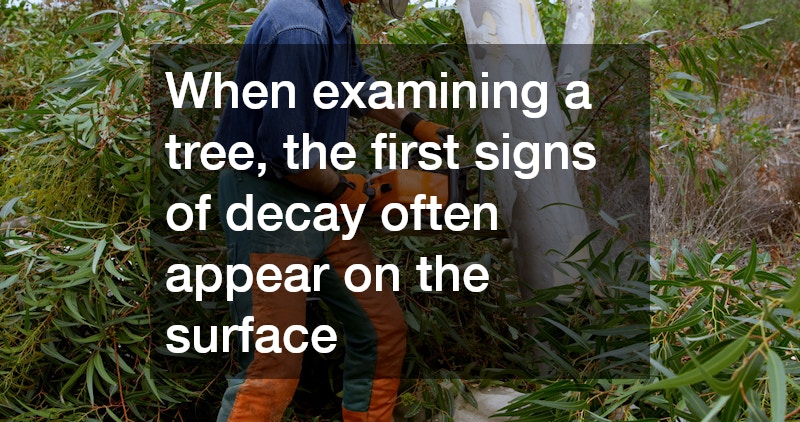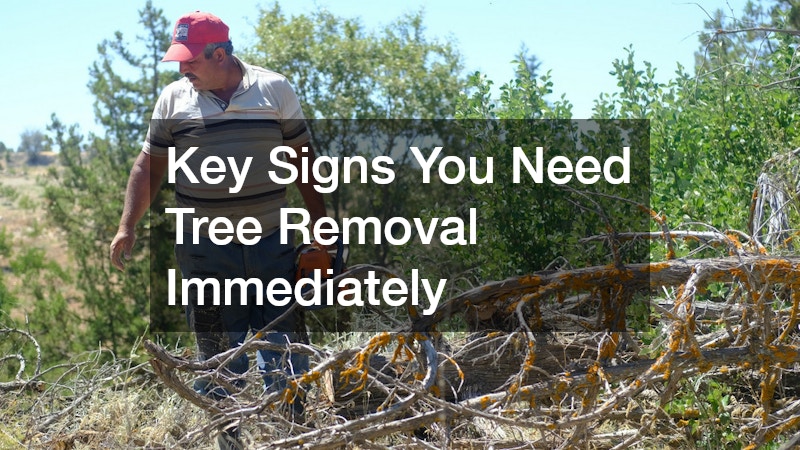There are various crucial signs that indicate a tree needs to be removed immediately to ensure safety and preservation of your property. Trees are essential for our environment and can enhance the aesthetic value of our homes, but sometimes they can pose serious risks. Understanding when it’s time for tree removal is important for property owners, particularly in urban areas where space is limited and safety is paramount.
It’s not always easy to identify when a tree has become hazardous, especially if the symptoms aren’t immediately visible. Regular inspections and awareness of the signs can help prevent accidents and damage.
This guide is designed to help you navigate the sometimes complex world of tree health and safety, empowering you to make informed decisions about your trees.
Visible Signs of Decay
When examining a tree, the first signs of decay often appear on the surface. Look for any unusual growths, such as mushrooms or fungi, which can indicate rot within the trunk or roots. Visible cracks and splits in the tree’s bark can signal that the structural integrity of the tree is compromised, making it less stable and more likely to fall. These surface issues are often the first warning signs that your tree may be in decline.
Another critical aspect to observe is the health of branches and leaves. If a tree is experiencing significant leaf loss or if the leaves are discolored, it may indicate that the tree is struggling. In some cases, trees may exhibit signs of cankers or other lesions, which can lead to further decline. Monitoring leaf and branch health can provide useful insights into the overall vitality of the tree.
Finally, if the decay is severe, you may notice an unusual movement in the trunk or branches, particularly during strong winds. If a tree appears unstable or has begun to tilt, it’s an urgent sign that professional evaluation is necessary. Remember, ignoring these visible signs could lead to dangerous situations, especially if the tree is near homes or walkways.
Leaning Trees
A leaning tree can be a cause for concern. It’s not uncommon for trees to lean slightly, but sudden changes in tilt are alarming. Factors like soil erosion, heavy winds, or water accumulation can cause a tree to lean and become unstable. Observing the surrounding environment for these changes can help you determine the urgency of tree removal.
If the lean is accompanied by root exposure or damage, this can exacerbate the risk of a fall. Roots are essential for a tree’s stability and nutrient uptake. If they are compromised, the entire tree can become a hazard. Regularly check the area around the base of the tree to ensure the roots remain intact and don’t show signs of injury.
Finally, if the tree is leaning toward structures, roadways, or high-traffic areas, it poses an immediate risk. It’s advisable to consult with an arborist who can assess the risk and recommend an appropriate course of action. Remember, proactive measures can avert potential damage or injury and safeguard your property and its occupants.
Dead or Dying Trees
Identifying a dead or dying tree can sometimes be perplexing. A dead tree often lacks leaves during the growing season and may exhibit brittle branches that break easily. If you notice a tree that fails to leaf out or shows signs of severe discoloration, it is likely suffering from death or significant decline. Pay special attention to any sudden changes in the tree’s appearance that may have developed in a short period.
Additionally, a tree that is dead often has a hollow trunk or cankered areas, which can be signs of advanced decay. Sound the trunk by tapping it; if it sounds hollow, this is a clear signal that the tree is no longer healthy. Furthermore, noticing a lack of sap flow can also indicate that the tree is dead or struggling to survive.
Lastly, consider the surrounding environment. If neighboring trees are healthy and thriving while one is dying, that tree may be a singular case of decay. However, if there are repeated incidents in the area, it could point to systemic issues. Consulting with a professional can help determine if removal is necessary to prevent the spread of disease to healthy trees.
Pest Infestations
Pest infestations can have devastating effects on trees and, in some instances, signal that removal is necessary. Insect activity can often go unnoticed until it’s too late, so regular inspections are essential. Look for signs such as sawdust or bore holes which indicate wood-boring insects have taken up residence in your tree. The presence of these pests can result in internal decay that weakens the tree significantly.
Common pests that indicate serious issues include beetles, aphids, and certain types of caterpillars. These pests not only harm the tree but can also affect the surrounding plants and trees, compounding issues within your landscape. Quick identification and action are crucial to mitigate further damage, which may involve the removal of the infested tree.
Furthermore, trees under pest attack may also attract secondary issues, such as fungal infections or the spread of diseases. Observing a tree for rapid declines in health or unusual blooming patterns is vital. If you suspect a major pest issue, reaching out to pest control or an arborist for assessment should be a priority.
Recognizing the signs that a tree needs immediate removal can prevent potential hazards and ensure the health of your landscape. If you notice any of the signs discussed, it’s crucial to consult with a professional arborist for evaluation. Timely action can make a significant difference in safeguarding your property and ensuring the safety of the people who frequent it.
Maintaining your trees is an essential part of home ownership, especially as they age and face environmental challenges. Being aware of the signs of decline and acting accordingly can help protect your investment and the well-being of your surroundings. Remember, a proactive approach is always more beneficial than dealing with the aftermath of avoidable hazards.
Whether it’s tree decay, leaning trunks, or infestations, being informed is your best defense. Make it a habit to inspect your trees regularly and take action when you spot any concerning signs. Doing so will ensure a safer and more vibrant landscape for generations to come.



